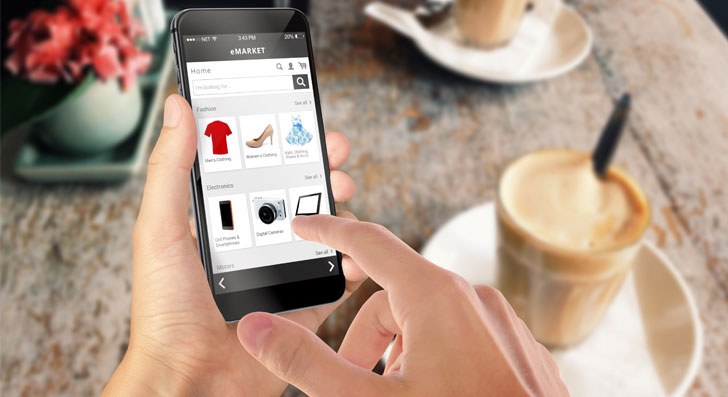
Mobile Commerce
Where will m-commerce take us in 2016 and beyond?
If in the year 2003 you had predicted that in 2015 the average person would do his shopping from his mobile phone (M-commerce), you’d probably have been looked at as if you had three purple tentacles wiggling out of your head.
Well, the year is 2015, and the reality is that the average person is doing much of his shopping from his mobile phone. He’s doing his grocery shopping, clothes shopping, electronics shopping; he’s booking in holidays and massages and ordering pizza on a Friday night, all from his mobile device.
In fact, over 50% of Australians currently use their mobile to do their shopping, and over 75% of Australians are shopping on their tablet. Goldman Sachs predicts that by 2018, consumer spending via mobile devices on a global scale will rise to a staggering $626 billion.
When you think about the way that mobile technology has been evolving, in terms of rapidity and general awesomeness (i.e., the general power and functionality that mobiles now pack), it’s no surprise that the growth of M-commerce has climbed so quickly and integrated so seamlessly into consumer habits around the globe. Not everyone likes the hustle and bustle of shopping in brick and mortar stores. Sure, some do; there are people out there who thrive in retail environments, who get a rush out of finding that perfect, glittering item in a cluttered field of failed potential. But many of us, myself included, much prefer doing the shopping without the shops.
So when online shopping came along, a collective sigh of relief sprouted from the dark shadows of abodes all over the world, but the active word here is abodes. Because at the time online shopping became a thing, the only platform on which online shopping was possible was from a desktop or laptop.
Putting the 'Mobile' in M-Commerce
Today, however, the mobile in all its glorious variations is more than capable of fulfilling this consumerist role of buying things. Thusly, that the mobile has started to rival desktops and laptops in e-sales really is of no surprise.
When we speak about M-commerce then, we’re speaking about an entirely different concept than what we were when online shopping was limited to desktops and laptops. Why? Well, the answer lies in the term mobile.
Unlike online shopping that happens on a laptop or desktop, m-commerce can take place anywhere and at any time. People can shop while they’re on the toilet or at a friend’s house, walking down the street or at a yoga session; they can even do it while they’re in competitor brick and mortar shop comparing prices between stores. Herein lies one of the other fundamentally important aspects of the M-commerce experience, beyond it being mobile. It’s not entirely correct to think of M-commerce as merely online shopping on the go. M-commerce is indeed an entirely new way of online shopping.
How M-Commerce Differs

In-App Pruchases
Think, for instance, about in-app purchases. Mobile apps are nothing like the apps on a desktop; the way in which we use and interact with them is totally different. Businesses that use M-commerce apps to promote and sell their products develop a special relationship with their customers in that they can communicate with them directly through the app via push notifications. This sort of online shopping is nothing like anything you get on a desktop or laptop. Sure, location-based marketing can be used when connecting with people at home. But it’s no way near as effective or personal as it is on the mobile platform.
Interaction & Engagement
Another way in which M-commerce differs to e-commerce is the way consumers can interact with products while they’re actually in store. There are many cases where M-commerce is an interactive experience, where people use their phones to dynamically scan and bring products to life. There’s a great example of Ikea doing this (or a slight variation of this) with their product catalog, which you can read about in more depth here. If you’re not inclined to click the link, what it basically involved was Ikea’s efforts to help people determine whether furniture would fit where they imagined it should go in their homes; the catalog would be placed in the intended position, followed by the customer opening her camera through the Ikea app, and voila! A virtual image of the product in question would pop up on screen, giving a fairly good indication as to its size and shape relative to the surroundings.
In-Store Posters & Scannables
Other businesses use in-store posters and scannable that shoppers can scan and interact with in a similar way to the Ikea example, either linking shoppers to promotional material or giving them discount coupons to use in store. Geo-fencing marketing is another mobile-centric marketing application that feeds directly into M-commerce smoothly and effectively, which involves an invisible fence set up either at a business location or even a competitor’s business location that triggers a notification—usually sent via SMS or email—when the barrier (fence) is breached by a potential customer. (You can read a bit more about geo-fencing here.)
Getting it Right
For businesses that want to make the most of this new world of M-commerce then, it can sometimes feel a little bit like staring out into some abstract abyss made up of differential equations and foreign languages. It’s true; there is no one size fits all approach that people should just apply to their business, and it can all get a little confusing at times. But there are some general notes that businesses of all shapes and sizes can start thinking about.
First and foremost—and this is a non-negotiable for any business that has an online store—websites have to be responsive. If your site isn’t mobile friendly— i.e., if it doesn’t reconfigure itself to suit the smaller screen—your business won’t rank well on Google, and more than that, the M-commerce experience will leave a bad taste in your customers’ mouths. Beyond that very simple point though, everything is up for grabs. So here are some other fairly general tips to chew on.
If you’re thinking about developing or have already developed an app to sell products through, make sure that the app a) is easy to use, so in-app conversions are super simple, b) actually works and c) rewards your customers for actually using the app. For example this could include special app-only discounts, sales offers or bonus credit loyalty features.
If you’re not in a position to develop an app, you could consider placing QR codes in your store that encourage customers to get interactive, and that lead your customers to special promotions redeemable either in store or through your site, or even that play a promotional video encouraging shoppers to take the plunge and spend some cash.
One Final Message...
The M-commerce landscape is constantly changing; it’s changing so fast that we can barely keep up. Alas, this isn’t an excuse to just sit around, throw your exasperated hands in the air and concede defeat.
No, we might not know where the near future of M-commerce lies, whether it will continue to make incremental steps forward and unfold itself in the rather banal tech innovations like Apple Pay? Or be subverted by the new completely shopping method of augmented realities evident already in the Oculus Rift and the upcoming Valve 3D, transforming the online shopping experience into something more like the brick and mortar experience, but without the crowds or the need to actually put on pants and leave the house?
Well, we know that the latter of those two scenarios is the most likely to dawn, but we don’t know when. Again, to reiterate, that doesn’t mean businesses should sit on their laurels and wait for the mobile world to settle down into some sci-fi, technologically fuelled reality, because it will never completely settle. Mobile technology and so M-commerce will always be evolving. The businesses that get creative and capitalise on these changes are the ones that will thrive.
